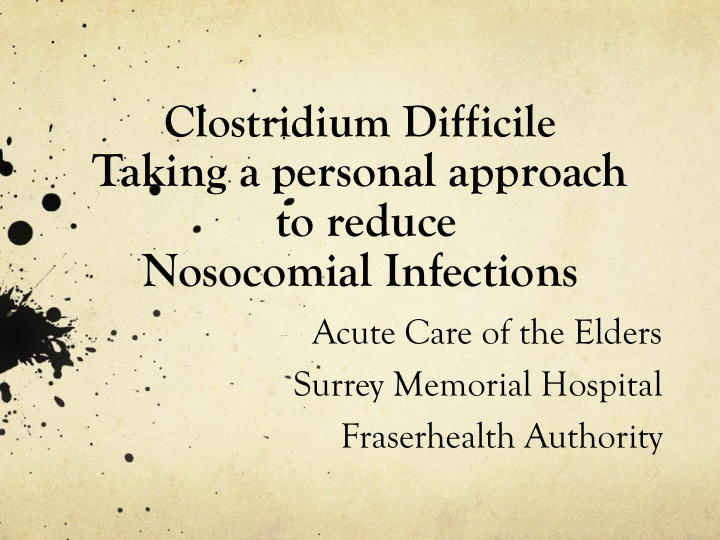



Clostridium Difficile Taking a personal approach to reduce Nosocomial Infections Acute Care of the Elders Surrey Memorial Hospital Fraserhealth Authority
Disclosure We have no relevant financial or non financial relationships to disclose
Nosocomial C-difficile was a way of life The SMH Acute Care for the Elderly (ACE) unit was one of the top 2 units in Fraserhealth (FHA) plagued with nosocomial C.difficile (CDI) The CDI rate for this unit was very high at 35.1 and 28.6 per 10,000 patient-days, respectively, in comparison to the FHA target of 6.0. These rates were among the highest across all acute care units in FHA.
Patient population at highest risk Our patient population at highest vulnerability of any population group: Complex, frail aging population Multiple co-morbidities Multiple antibiotics Advanced age Year ending April 1, 2012 we realized 4 8 nosocomial cases
We began to take it personally The following year we reduced that to 38
How did we do this? Discussed the fact that we as a unit had a challenge with C.difficile Acknowledged to site and regional leaders that C.difficile was a common complication of being admitted to our unit. Talked about C.difficile with our patients and their families
How did we do this? Created a multi-disciplinary team; Management - Older Adult Program Manager Unit leadership - Patient Care Coordinator, Clinical Nurse Educator Front line champions - RNs, Care Aides Unit clerks, Allied health – PT, OT Infection Prevention and Control Practitioners, Housekeeping as well as BISS.
Initial Steps taken… We audited infection prevention and control practices specific to our unit. Identified gaps and deviations from recommended best practices. The audit was conducted using a standard tool developed by the FH Infection Prevention and Control (IPC) Program.
Gap Analysis identified Key areas to target Hand washing, hand washing, hand washing Education needs; staff, physicians, patients, visitors, Environmental monitoring Proper accommodation of patients, private is best Dedicated toileting facilities; Appropriate collection of stool samples through the use of the Bristol Stool Chart (regardless of admitting diagnosis!) Staff education around clinical knowledge of CDI and best infection prevention and control practices…physicians too!
Hand hygiene was not a given… Weekly audits of staff hand hygiene compliance; humour Established a process for patient hand hygiene (before/after meals, after toileting); involving a neutral wipe using friction and alcohol-based hand rub (ABHR);
Unit Clinical Leadership Increased hand hygiene audits, at first weekly then biweekly Daily use of decluttering tool Daily re-enforcement of Bristol stool chart Regardless of diagnosis, all stool was assessed according to Bristol Stool Chart ALL patients were considered at risk for CDI Daily re-enforcement of infection control practice
Housekeeping Complete cleaning of the unit with sporicidal disinfectant Strengthening reprocessing practices such as dedicating equipment when possible and cleaning & disinfection of shared equipment; Ensure proper cleaning techniques Additional training as required Especially important for replacement housekeepers
Action by housekeeping (at leadership level) Housekeeping Additional cleaning hours Change to bleach product Discard toilet brush and floor mop between every room Additional audits
Infection Control Monitor and track cases Look for patterns Provided daily support to clinical leaders
Action by Infection Control (at leadership level) Infection Control leadership supported the unit to upper level leadership Close hallway beds Increased environment audits
Action by frontline nursing Daily use of Bristol Stool chart on ALL patients regardless of admitting diagnosis Collection of specimen after 3 X #7 (stool must meet criteria for C Diff, not physician order or the result of laxative use). prevented taking colonized specimens. Staff became proactive; not afraid to confront fellow staff members and visitors about following strict isolation practices. Classic conversation now is, “are those clean or dirty?”
More targeted action Individual use equipment BP Cuff Transfer belt Toiletries PT Equipment Patient Hand Hygiene Moist wipes before every meal Personal hand sanitizer
Unit practices began to change Declutter family members asked to take home personal belongings Eliminate any storage of supplies in patient area Remove linen carts from the halls Reduce clutter at bedside Eliminate clutter on window ledges
Action by Unit Clerk Identified patients with confirmed or suspected CDiff by using a coloured dot on their patient board. Communicated to porters, lab, etc that the patient was suspected or confirmed CDiff. Once the third #7 stool specimen sent... Patient instantly put on contact precaution plus until proven negative. Made sure clear signage on the patient’s doors re: contact precautions Cleaned phone, keyboard and mouse with Virox Frequent terminal cleans for when patient off floor (test, shower etc)… all aimed at reducing bio-burden.
Action by Manager Ensured staff felt supported and not "on their own"... Available 24/7 to support In Charge’s decisions “conversations" with site leaders during times of congestion Staff observations/challenges with lab, porters and housekeeping… would be escalate to educate the site. Support unsung heroes Be open with those staff seeking employment that we have a C Diff problem
A shift in culture Any staff, physician or visitor observed in Personal Protection Equipment was challenged “are you clean or dirty”
Reduce that bio-burden! All practices focused on reducing, ‘bio-burden” “When in doubt isolate” “When in doubt, throw it out”
Results were dramatic! Reduced C Diff rates (Only 4 cases from April to September last year) Increased staff morale Success is a huge motivator
Recommend
More recommend